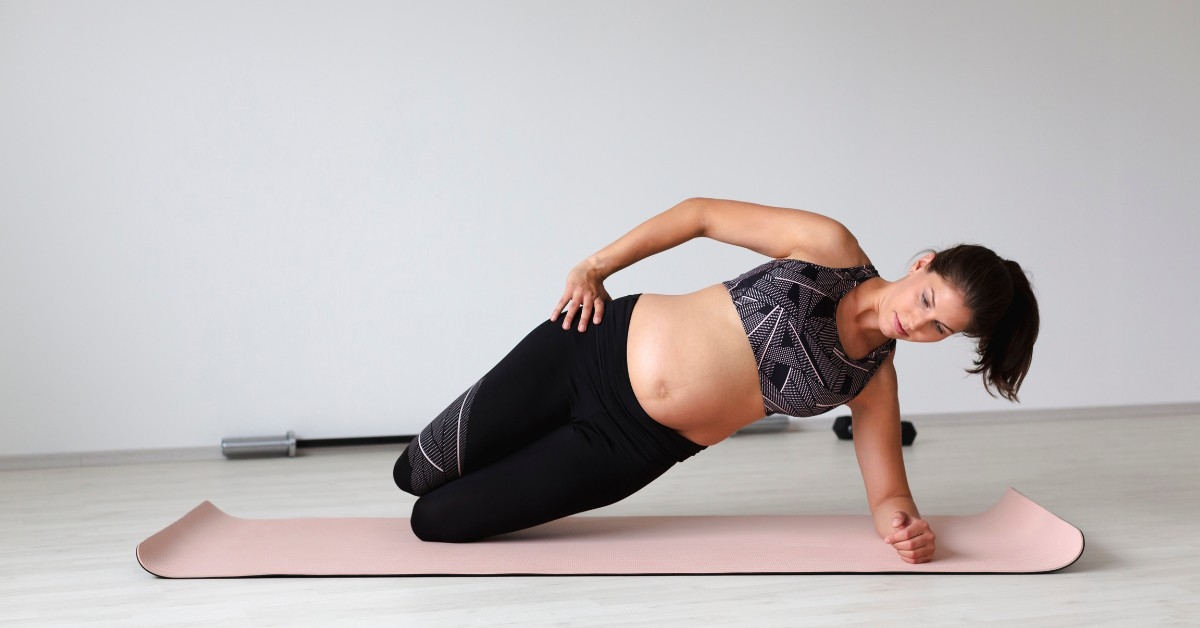I’m sure you already know – or have guessed – that it may take some workout to get your body back after pregnancy. This article provides some safe, easy postnatal exercises to try, including videos. We’ve also included tips to protect your back, neck, and shoulders while tending to your baby.
Why Abdominal and Pelvic Floor Exercises are So Important After Pregnancy
After giving birth, our abdominal and pelvic floor muscles can be significantly weaker. They have been stretched and pulled during the process of carrying and delivering your baby. In addition to still looking pregnant, there are some pretty nasty problems that can (but usually don’t) occur from the weakening of your abdominal and pelvic floor muscles:
Incontinence (the inability to hold your urine while coughing, laughing, or straining), is a common problem that arises from weakened muscles.
Uterine Prolapse is also a possibility (although only on rare occasions). This is a condition where the pelvic floor muscles are no longer able to support the uterus; therefore, it dips down and can come out of the opening of the vagina. Good news, though. We can prevent these things from happening with targeted exercises.
Look below for some easy postnatal exercises that will help you get started. But don’t start exercising too early after giving birth. You’ll find information on when and how to start exercising here.
Postnatal Exercises – Get Going!
Pelvic floor exercises (Kegel exercises)
These are a type of very important postnatal exercises. They strengthen the pelvic floor muscles and keep them healthy. These exercises can prevent or mitigate the type of urine leakage that is so common after pregnancy, when you, for example, jump or cough.
First exercise: Try lying on your back and pulling in tightly with your vaginal and anal areas. This is similar to stopping the flow of your urine. Hold this tightening for 5 to 7 seconds, and then rest. Repeat this about ten times a day.
Second exercise: Another variation of this exercise is to pull the muscles in quickly and let them go quickly, like a flicker. Do this as quickly as you can for 10 seconds, and repeat ten times a day.
Once you have learned how to carry out these exercises, you really don’t have to lie down to do them. Sitting, standing, or walking works fine too. Since you then can do these exercises anywhere, make it a rule to do them, for example, while feeding your baby, cooking, or whatever makes you remember to do them.
Ready for more?
The above two exercises are a great start and super simple to repeat throughout the day. In the video below, you’ll find a number of additional pelvic floor exercises to try.
To keep your pelvis stable after pregnancy and prevent back pain, exercising the glutes is also very beneficial. The website FitAsAMamaBear provides a thorough guide to glute dominant exercises. (Opens in new window)
Abdominal exercises
After you have your baby, you will want to begin exercising slowly. Don’t push yourself too hard, and stick with light exercises. After all, your baby needs you to get healthier, not blow a head gasket!
As many as two-thirds of all new moms may have some degree of diastasis recti (abdominal separation), and it is very important to do the right type of abdominal exercises to strengthen the core.
If you have a degree of diastasis recti, do not, and I repeat, do not, do crunches and situps! These exercises can make the condition worse!
First exercise: Try lying on the floor, tilting your pelvis to minimize the space between your lower back and the surface you are lying on, and sucking in your tummy. To get the right method, imagine that someone is on the inside of your belly, pulling it in from the belly button. Hold this for about 10 seconds, and repeat ten times a day. Do not hold your breath!
Second exercise: Another great exercise is to breathe out and suck in. Lie on your back with your knees up, and keep your hands out flat beside you. Breathe out as much as you can. When you have no air left, suck in your belly and hold this for around 5 seconds. Repeat 10 times. This is a great way to strengthen your abdominal muscles.
The below video will show you a few additional, safe, postnatal abdominal exercises to try out.
And until your belly has started to get back in shape, remember to stretch your back and look proud. You’re a great mom! (And your belly will look smaller, too.:-) )
Protecting your back
After you have a baby, it’s important to take care of your back. Back pain is very common among new moms. Here are a few great ways to keep yourself healthy and allow your back to get stronger.
- For the first couple of months after you give birth, don’t lift anything heavier than your baby. This will ensure that you don’t strain yourself.
- If you must lift something, such as picking the baby up from a low place, bend at your knees. Use the strength of your legs to lift, not your back.
- While sitting, try to maintain proper posture. This is keeping your spine straight and not slouching. This is a great way to strengthen your back.
- When pushing your stroller uphill, don’t use straight arms. This is a very natural thing to do, but it puts unnecessary strain on your back. Bend your arms and keep the stroller close to your body.
- Combining yoga with strengthening your abdominal muscles is another great way to prevent or reduce back pain.
Neck and shoulders
Sore neck and shoulders are also greatly helped by yoga and by stretching those muscles as often as possible.
If you breastfeed for an extended period and don’t sit in a perfect position every time (who does…), don’t be surprised if your neck and shoulders start hurting and get stiff. It’s very common but not very nice.
More Exercising Tips For Mom…
- Post-Pregnancy Exercise – When And How
- Tips On Mom And Baby Exercise At Home And Outside
- 5 Fun Ways To Reclaim Your Waist After Pregnancy

Paula Dennholt founded Easy Baby Life in 2006 and has been a passionate parenting and pregnancy writer since then. Her parenting approach and writing are based on studies in cognitive-behavioral models and therapy for children and her experience as a mother and stepmother. Life as a parent has convinced her of how crucial it is to put relationships before rules. She strongly believes in positive parenting and a science-based approach.
Paula cooperates with a team of pediatricians who assist in reviewing and writing articles.








I find this very helpful to me with these great postanal exercises since I’m really eager to get my figure back :)
I am happy to hear that you find them helpful! :-)